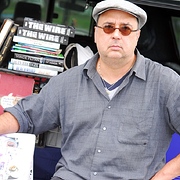Rafael Alvarez (1)
Autor von The Wire: Truth Be Told
Andere Autoren mit dem Namen Rafael Alvarez findest Du auf der Unterscheidungs-Seite.
Werke von Rafael Alvarez
Zugehörige Werke
Getagged
Wissenswertes
- Geschlecht
- male
- Nationalität
- USA
- Geburtsort
- Baltimore, Maryland, USA
- Ausbildung
- Loyola College
- Berufe
- journalist
screenwriter - Organisationen
- Baltimore Sun
Mitglieder
Rezensionen
Auszeichnungen
Dir gefällt vielleicht auch
Nahestehende Autoren
Statistikseite
- Werke
- 9
- Auch von
- 1
- Mitglieder
- 351
- Beliebtheit
- #68,159
- Bewertung
- 3.8
- Rezensionen
- 5
- ISBNs
- 20
- Sprachen
- 1













This book tells the story of "The Wire", which is one of my favourite TV series, ever. It starts with an essay about the nitty grit by David Simon himself, and then goes through every single episode of all five seasons, interspersing mini-essays, interviews and a billion tidbits.
At its worst, I just quickly sifted through the recaps of the episodes, but that's not "worst", it's just good. So, at its best? I think Simon is always interesting to read, not only because The Wire is really a Greek drama as spliced with Shakespeare, but one of the best series ever, due to its tight writing, acting and setting. Even the audio recordings, as detailed in the book, match and often overtake those from books.
Simon attacks both the so-called war against drugs and capitalism, naturally; it's plain to see the money behind the drugs, and behind the rich, white guys in the foreground. It's not Baltimore that's a messy town, it's the money and why they are:
Through the book, I learned that a lot of info was from reality. Bubbles, Ziggy, they actually lived.
Also, Simon was fortunate and happy to get writers like Lehane, Pelecanos and Price on his hands:
And what about feminism and The Wire?
About the ever-loveable Bubbles:
And the music?
As I stated, tidbits everywhere... Here's one on Omar's whistle:
Also, Dennis Lehane on Omar's death:
More tidbits:
All in all, as far as I know, this is the definitive word on The Wire, unless Simon, Burns or somebody else high-up in the echelons of power decide to publish something. But all in all, this is about as hard-boiled as you will get with the series. Go forth, buy this and prosper further in The Wire.… (mehr)